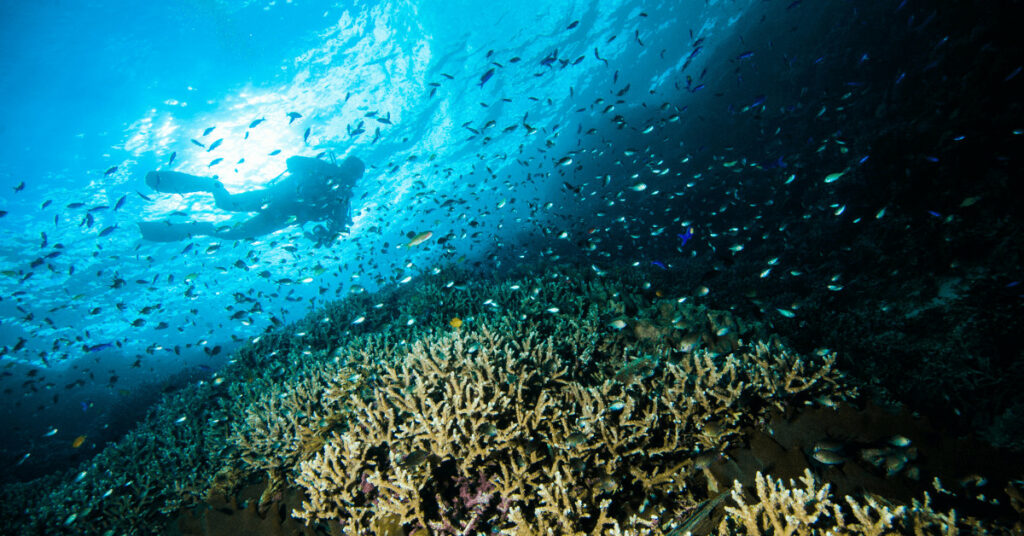The ocean has traditionally been overlooked as a solution in climate change.
However, ocean-based climate solutions have the potential to deliver one third of the annual greenhouse gas emission cuts needed to limit global temperature rise to 1.5 degrees Celsius by 2050 – a much larger role than previously thought.
For Indonesia, the largest archipelagic country on earth and among the world’s ten biggest emitters, the potential of ocean climate action is even greater.
In fact, a new report by Climateworks Centre shows ocean-based mitigation can contribute 49% of Indonesia’s net zero emissions transition.
The report, Sea of Opportunity: Ocean-based mitigation to support Indonesia’s climate ambition, was showcased at the recent International Conference on Integrated Coastal Management and Marine Biotechnology in Bali.
It details findings from Climateworks’ philanthropically-funded Southeast Asia Framework for Ocean Action in Mitigation project – SEAFOAM for short.
Phase one of SEAFOAM collated qualitative and quantitative data on three sectors:
- Blue carbon nature-based solutions
- Maritime industry and infrastructure
- Offshore renewable energy.
The SEAFOAM team mapped and measured Indonesia’s potential in each of these sectors, identifying significant opportunities for the inclusion of ocean-based action in the country’s updated nationally determined contribution (NDC), due in 2025.
The findings demonstrated that Indonesia could become a regional leader in ocean-based mitigation through enhancing efforts to limit global warming to 1.5 degrees Celsius.
Expanding protection and restoration of blue carbon ecosystems
Indonesia’s blue carbon is globally significant, housing 17% of the world’s mangrove and seagrass forests (Alongi et al. 2016). However, rates of decline of mangroves and seagrasses could have a significant impact on the country’s emissions profile.
The protection of blue carbon is vitally important, because damaged or degraded ecosystems can alter from a GHG sink to a source of carbon dioxide, methane and nitrous oxide (Hiraishi 2013, Oreska et al. 2020, Vanderklift 2019).
To support enhanced protection and restoration of mangroves and seagrasses in Indonesia, the report recommends setting specific targets and mitigation strategies in the next NDC. Specifically, including seagrasses in NDC monitoring and reporting and committing to their protection and restoration has the potential to mitigate 17–60 MtCO2e per year by 2030.
Decarbonising the shipping and maritime transport sector
Indonesia occupies a strategic position for international trade routes, while its domestic maritime industry moves a significant amount of people and goods between its islands.
In Indonesia, domestic maritime passenger transport has clear pathways for decarbonisation. Options to reduce maritime passenger transport sector emissions range from the introduction of lower emissions fuels to the near total elimination of emissions through electrification supported by renewable energy sources.
If emissions from this sector were reduced in line with IRENA decarbonisation pathways, they would achieve a reduction of 1.9–2.6 MtCO2e annually by 2030 and 5.2–7.4 MtCO2e annually by 2050.
Investing in offshore renewable energy
Over the past 30 years, Indonesia’s population has grown by more than half, with energy demand increasing by around 237%. Although population growth is expected to slow, electricity demand is forecast to grow by 4.9% annually by 2030, in line with Indonesia’s ambition to become the world’s fifth-largest economy by 2045.
The marine environment has the potential to provide multiple sources of clean energy through offshore wind farms as well as renewable ocean energy. This latter category includes wave energy, tidal energy, and ocean thermal energy conversion (OTEC). Deployment of renewable offshore energy offers the same low-emissions advantages as onshore, but without the requirement for land.
Deployment of a mix of four offshore energy technologies – wave, tidal, offshore wind and ocean thermal energy conversion– could mitigate 0.83 MtCO2e per year by 2030 with rapid acceleration to 2050.
Conclusion
The ocean has a significant role to play in progress towards curbing the impacts of climate change and helping to sustain the health of the planet. Indonesia’s blue ecosystems and ocean-based sectors hold the potential to close the gap towards net zero, with blue carbon ecosystems and offshore renewable energy presenting key opportunities for net zero aligned pathways.
Climateworks Centre is currently engaged in rolling out the next phase of SEAFOAM with a focus on convening, capacity building and knowledge product development.
More details on the research and findings are available in the SEAFOAM Summary report.


















